Watch my video reflecting on Citizen Science!
Month: May 2017
AP Biology Exam
Well in today’s post I will be reflecting on my AP Biology Exam, or rather… the part of it I took. I could not make the original AP Biology exam that the rest of the class took because I was on an airplane ride home from Louisville, Kentucky. Therefore I was scheduled to take my exam on Friday the 19th! However… things did not go as planned.

I went in that morning bright and early and sat in Ms. Cerles office. She read me all the instructions, and just as I was about to begin, I noticed that the front page said that if the test was being administered to me anytime before 12 pm, to immediately stop. Being that it was 8 am, I questioned this. Ms. Cerles called Mrs. Cunha who said all should be fine and I went ahead with my test. As I am on one of the last questions and over an hour has passed, Mrs. Cunha bursts in the room talking on the phone needing my student ID immediately saying that I must stop the exam. She later comes back to tell me that she was speaking to college board and they said that my exam needed to be canceled since I was taking it at the wrong time and that I would have to reschedule. I also needed to write a hand written note saying I would not speak about the testing material. Then, I went back to AP Bio class.
I am not upset at all. To be quite honest, I did not expect to pass the AP Biology exam in the first place, and I wasn’t too keen on taking it in the first place. Sure, I am slightly annoyed that now I have to go through another multiple choice section of AP Bio (because to be honest, I dozed off a couple of times during the test) but in the scheme of things, its whatever. I am not upset with Mrs. Cunha or Ms. Cerles because it was an honest mistake! Now I have more time to study, if I so choose to do so. The part of the test I did take was not at all as hard as I expected it to be! But I am not getting my hopes up. I am taking my new test this friday so let’s hope I do well!
Let’s Talk About Biases
Confirmation Bias (noun): The tendency to interpret new evidence as confirmation of one’s existing beliefs or theories.
Picture this…you’re arguing with someone and backing your statements with facts, however, the other person refuses to see it your way. I’m sure we have all experienced this, and it has driven many of us crazy. Their refusal to see it your way is likely because of confirmation bias which causes many people flat out ignore or disregard information that conflicts with their opinion. To get past this, the first step is realizing that we all have a bias regarding our own opinions and that we may not understand everything as well as we think we do! In this post, I am going to do the #DoNowConfirmationBias from KQED. This do now asks me to pick a controversial topic and research what the other side believes and why they believe this! The topic I have chosen is animal testing! I support animal testing because it has led to so many lifesaving medical cures and treatments, the animals are treated humanely by law, and there are no other real alternatives, to name a few reasons. But let’s get into why people are against animal testing. Warning: this blog post may contain graphic images.
- There is data suggesting that animal testing is actually cruel and inhumane. In 2010 the US Department of Agriculture reported that 97,123 animals have suffered pain with no anesthesia during experiments. For example, the Draize eye test (used by cosmetics companies) is done to test irritability caused by shampoos and other products, however, this test requires rabbits to be kept with their eyelids held open by clips (sometimes for days on end) so that they cannot blink. ouch

The stock rabbits are kept in to prevent them from moving or cleaning out their eye - Alternative testing methods exist, thus we can replace animal testing. In glass testing is known as in vitro testing which is where cells cultures in a petri dish are studied using human cells. Also, microdosing is a form of testing where small doses are given to human volunteers (doses too small to cause bad reactions) and then their blood is analyzed. Instead of testing chemicals on rabbits skin, researchers can use artificial human skin. And these are just three examples!

In Vitro testing - Animal testing does not predict reliable results in humans! Data shows that a whopping 94% of drugs that pass animal testing fail when given to humans in clinical trials.
- Animal testing is VERY expensive. Humane Society International discovered that an “unscheduled DNA synthesis” animal test costs $32,000 compared to the in vitro alternative which costs $11,000. It is also important to note the US National Institutes of Health (NIH) spends $14 billion of its $31 billion annual budget on animal research!
- Being that animals can suffer in the way humans do, it is speciesism to experiment on them. People opposed to animal testing often argue that just because animals lack the cognitive ability, language and moral judgment that humans have, does not mean they can be tested on. They often equate this to testing on humans with sever mental impairments, which we know is not right. An english philospher Jeremey Bentham once said,
The question is not, Can they reason? Nor, Can they talk? but Can they suffer?
These are just five of the reasons why many people are against animal testing, and I encourage you to look into it for yourself and reevaluate your own opinion. I still believe that despite these cons, animal testing is beneficial, but my beliefs have been challenged and I now have more appreciation for the cures and treatments that successfully come out of animal testing.
Sources:
“Animal Testing – ProCon.org.” Should Animals Be Used for Scientific or Commercial Testing?N.p., n.d. Web. 23 May 2017.
Engebretson, Monica. “Seventy Years Is Enough: It’s Time to Put the Draize Test Out of Its Misery.” The Huffington Post. TheHuffingtonPost.com, 16 Jan. 2014. Web. 23 May 2017.
Redazione. “REACH: taking up alternatives to animal testing.” Kosmetica World. N.p., 06 Nov. 2014. Web. 23 May 2017.
Wolbachia Lab!
Purpose: The purpose of this lab was to determine how many of the collected Bay Area insects have the Wolbachia bacteria in their DNA
Introduction:
- What is Wolbachia?
- Wolbachia is a bacteria infecting arthropods and nematode worms that can change the sex of the host as well as kill their offspring
- Why is Wolbachia being studied? What did you discover in your research?
- Studies have shown that Wolbachia can be used to stop the mosquitos that spread diseases like zika and dengue and also finding ways to end this virus can be useful in curing diseases like Lymphatic filariasis (elephantiasis) and Onchocerciasis (river blindness.)
- What kinds of relationships does Wolbachia have with other organisms?
- Wolbachia is parasitic to other organisms as this bacteria benefits at the expense of the other organism Specifically, Wolbachia is an endosymbiotic parasite which means that it lives inside the host cell.
Techniques:
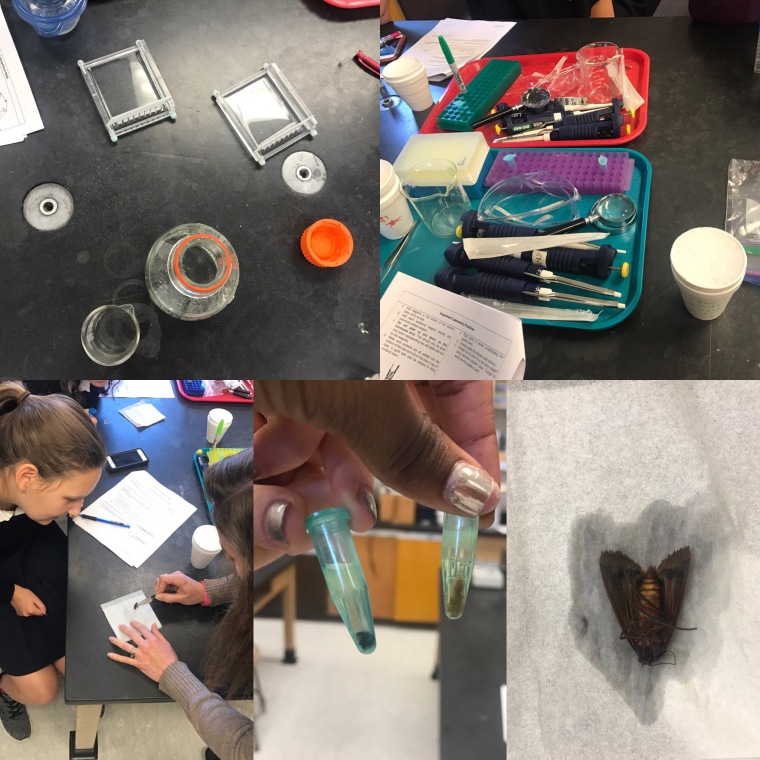
I was going to list out all the steps, but that would be a very long list! So, instead, I will summarize. First, we all brought in bugs from our houses or our surrounding areas and froze them in alcohol. Next, we mashed up the abdomen of the bug, and if your bug was a certain size, you had to cut it to make sure you just get the reproductive parts of the insect! I needed to cut mine because I caught (my dad caught) a moth and this bug was pretty big! After the abdomen was all smushed in our microfuge tubes, we had to separate the DNA from the pellet (the stuff we do not need). We did this by centrifuging many times and adding different liquids like NaCl and Lysis Buffer which bind together to give us a clear DNA sample. After going through multiple steps, it was time for the Polymerase Chain Reaction (PCR) machine which replicates the DNA thus allowing the electrophoresis gels to be clear. Also on the gel electrophoresis, we included a positive control and a ladder both of which help us determine what is DNA and what is Wolbachia so thus we know whether or not the insect had been infected with Wolbachia bacteria.
Results:
Personally, my moth was not infected by Wolbachia and had a visible DNA on the gel! Out of the 11 girls who performed this experiment, there were only 4 insects infected with Wolbachia and all of them came from the Redwood city/ San Carlos area. A coincidence? I think not.
Experience:
The experience of this lab was much easier and more fun than the other labs because I was more prepared being that I understand the topic and work more. Maybe it was the fact that this was my last lab and I had all the knowledge of my other labs in the back of my mind, or maybe I was just less stressed. Regardless, this was definitely my favorite lab being that I 100% understand what was going on. I understood all the tools we were using like the centrifuge and electrophoreses, even though occasionally I had micropipette troubles.
AP Bio Rockstars part 2!
In this AP Bio Rockstars round up, I am going to be telling you about the classes from May 7th to May 21st! In this time frame, we had a lot of fun, even if not everyone was present at all times! The class had some buggy visitors, we discussed Henrietta Lacks and her cells, we had a Wolbachia lab, and now we are working on our digital sites!
Although I was absent for the Arthropod visitors, my fellow classmates Natalie and Keira all had amazing blog posts about them that I will link at the bottom! Natalie blogged about a Lubber grasshopper which was the “sickest looking arthropod” she had seen all day! From her post, I learned that this little bugger is a vegetarian and that they bury their eggs in a sandy place for protection.
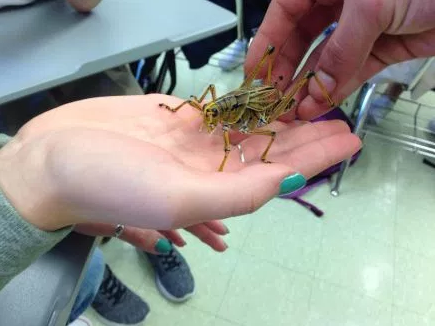
Natalie also posted about a Madagascar Cockroach, which is apparently very important to the food web because these arthropods can eat anything, and are also a food supply for others.
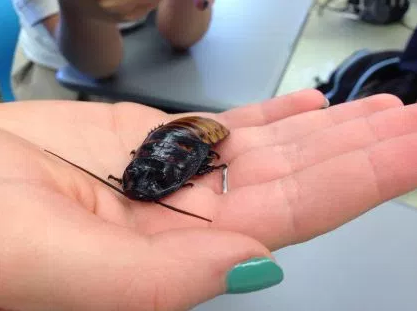
Keira is seen below holding a Giant African Millipede which is very fragile! This millipede can grow to have about 300 legs and live to be 20 years old! However, they only live this long assuming they do not get eaten by other organisms! I can tell you this much…if I saw this certain arthropod in my house (or anywhere for that matter), my two legs would carry me very far away and very fast.
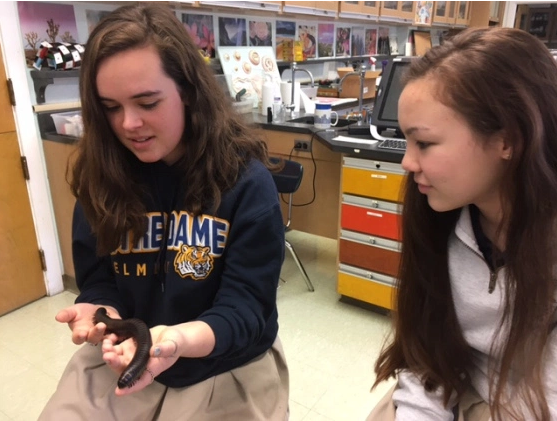
Keira also posted about her favorite creature of the day, the Whip Scorpion which has eight legs and one is super long which is known as the whip! From Keira’s post I learned that this arthropod has olfactory receptors thus allowing the organism to smell, in fact, they smell with their legs!
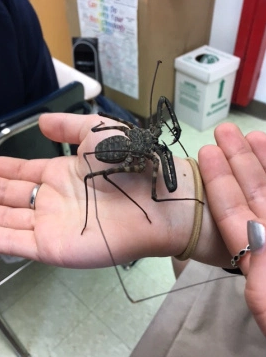
We also watched the Henrietta Lacks movie and blogged about it! Basically, Henrietta Lacks was a poor African-American woman whose cells were stolen from her without her knowledge and became known as the immortal HeLa cells. These cells have since been used for quite a lot in the medical and research field, yet her family was never compensated. Watch the trailer below, and the book is available as well!
We then started working on our Wolbachia lab this week, and get this, we all brought in bugs! THAT WE CAUGHT!!! Well my dad caught mine, but I digress. Wolbachia is a bacteria that infects arthropod insects and nematodes and feminizes them and kills their offspring. We collected DNA from our little buggies and when we get back to class we will be seeing our results!!
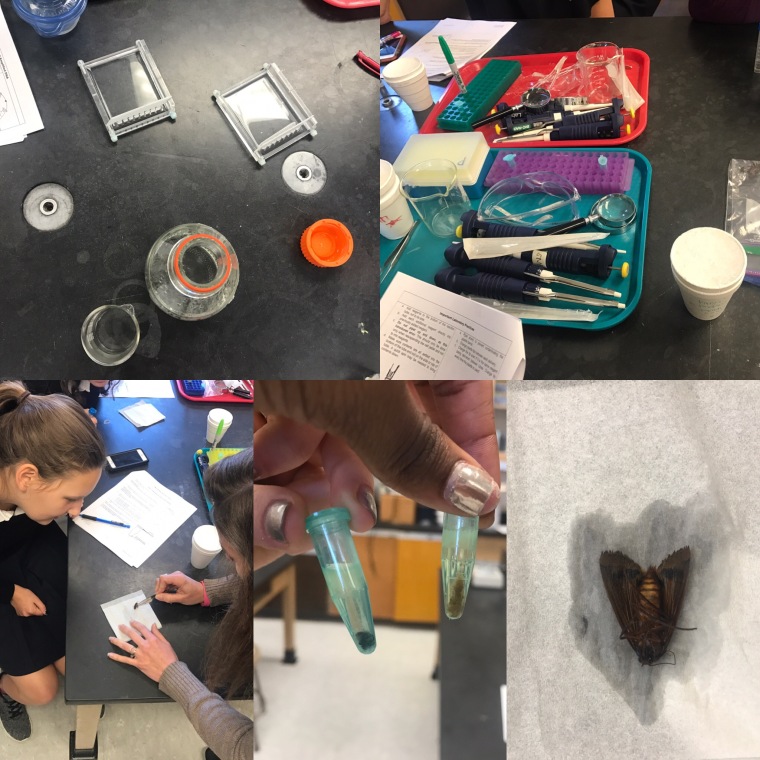
Finally we will be working on our sites quite a lot. We posted videos giving advice to the future ap bio girls, and we have many blog posts to write preparing for the end of class!! 11 days until graduation, the end is near and the journey has been great!
https://nsmith17.wordpress.com/2017/05/11/all-about-arthropods/
https://extempexploration.wordpress.com/2017/05/11/arthropod-adventure/
A Reflection on The Immortal Life of Henrietta Lacks

To begin, let’s go over the basics. Henrietta Lacks was a poor African-American woman of the 1920s who was diagnosed with cervical cancer at 31 years old. Cells from her tumor, known as HeLa cells, were taken without her consent and were discovered by researcher George Gey to grow and divide without limit thus making them “immortal.” This had a giant impact on the science and medical community, one that you most likely have benefitted from. The HeLa cells have been used to create the polio vaccine, aid in the understanding of cancer, cells, and HIV/AIDS, have been exposed to nuclear testing and toxins, have been to space, and are currently being used to grow viruses and test antitumor medicines. To put it shortly, the HeLa cells have done quite a lot! But for all this work… her family was left in the dark and they were not paid even a dime.
The book, The Immortal Life of Henrietta Lacks by Rebecca Skloot details how Henrietta’s daughter Deborah and the author Rebecca journey through understanding HeLa and Henrietta, as well as provides the reader with information about Henrietta’s life as a whole. What is important to note is that this most definitely is a race issue. Henrietta Lacks was mistreated by John Hopkins, mistreated by George Gey, mistreated by the companies that gained millions of dollars of her cells and the Lacks family is STILL mistreated as they have YET to receive compensation. The 1950s were not a pretty time racially, yes that I can admit. But there is no excuse as to why they have yet to be paid. Not one.

Reflecting on this makes me question my own beliefs, as I most definitely want to either go into medicine or into research, two key topics here. As a doctor, it would be my job to look after my patient with no bias, no matter what color, size, income, history, etc. As a researcher, I would need to equally understand that the end does not justify the means.
There is NO excuse for unethical behavior, even if the outcome is stupendous.
Can you imagine having such a large impact on the world and your family never knowing or receiving any benefits? That would be like Bill Gates, Steve Jobs, Mark Zuckerberg, Stephen Hawking and many more names I am sure we all recognize never being acknowledged for their contributions to society. But reading those names and matching them to faces… we all know the differences between them and Henrietta Lacks. I challenge you to look within yourself and determine whether or not something like this could happen today. Personally? I am absolutely positive it could. We have fixed a lot as a country in regards to racial issues but we still have so far to go.
I encourage you to read this book, you can get it on your apple device for $10.99 or in your nearest library! Or you can watch the movie, produced by HBO, which I will link below.
